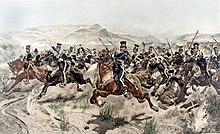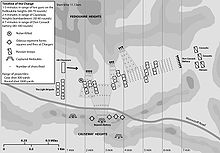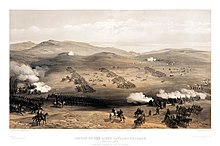Light Brigade attack

The attack of the light brigade or the death ride of the light brigade (English Charge of the Light Brigade ) was an attack by British cavalrymen in the Battle of Balaklava , in the Crimean War . She gained notoriety for the brigade's great losses and the circumstances that led to the attack.
Background and starting position
The battle took place almost seven weeks after the Allies ( British , French , Ottoman Empire ) landed in Crimea. During the siege of Sevastopol , the British were based in the port city of Balaklava . In front of the city are two parallel valleys, the north and south valleys. Both are separated by a range of hills called Kadikoj Heights or Causeway Heights. On these hills, nearly two miles from their positions, the Allies had erected four redoubts . These were manned by 3,000 Turks and equipped with nine twelve-pounder guns. The 93rd Highlander Regiment blocked the road to Balaklava near the village of Kadikoj. The light and heavy British cavalry brigades stood at the foot of the range of hills, with the French cavalry and artillery directly to the northwest . The Russians had brought in a relief army from Bessarabia and assembled about 8 kilometers away with 25,000 men and 78 cannons under their commander, Count Liprandi .
Structure of the Light Brigade
- Light Brigade - Major General Lord Cardigan
- 4th (The Queen's Own) Regiment of Light Dragoons - Lieutenant colonel Lord George Paget
- 8th (The King's Royal Irish) Regiment of Hussars - Lieutenant colonel Frederick Shewell
- 11th (Prince Albert's Own) Regiment of Hussars - Lieutenant colonel John Douglas
- 13th Regiment of Light Dragoons - Captain John Oldman
- 17th Regiment of Light Dragoons (Lancers) - Captain William Morris
The light brigade was part of the cavalry division. This was under the command of Lord Lucan , Lord Cardigan's brother-in-law.
The attack
During the Battle of Britain was commander Lord Raglan to General Airey orders to the cavalry to use in order by the morning Russian army captured guns recapture. Airey passed this order on to the orderly officer Nolan , who handed it over to Lord Lucan, commander of the cavalry division. The latter in turn gave the order to be carried out to his brother-in-law, Lord Cardigan, the chief of the light cavalry brigade.
From the brief order, however, it was not clear which cannons were involved. From his position in the valley floor , Lucan could only see the position of the Russians at the end of the northern valley. The gun emplacements captured by the Russians in the morning were on the other hand on the Vorontsov Hills ( Kadikoj Heights , Causeway Heights ), which closed the valley to the south. They were also directed towards the route the Light Brigade was to take.
Nolan was apparently of little help in clearing up the mistake. According to reports, he waved his saber and declared that he wanted to lead the attack himself. He told Lord Lucan: "There are your cannons, there is the enemy!" And pointed to the Russian positions. Lord Lucan ordered Cardigan to attack the Russian cannons across the valley. Cardigan's suggestion that a frontal attack with simultaneous fire from both flanks (the heights north of the valley had also been occupied by Russians, see Battle of Balaklava ) would lead to high losses, he rejected with reference to Raglan's order.
The brigade consisted of 673 men during the attack. The 13th Light Dragoons (13th Light Dragoons ), 17th Lancers (17th Uhlans ) and 11th Hussars (11th Hussars ) formed the first, the other two regiments the second attack wave. One of the first bullets killed Captain Nolan, who had realized his mistake and tried to hold Cardigan back. The French General Pierre Bosquet commented on the image of the troops galloping under fire from the front and from both sides with the now famous words: “This is great, but it is not war, it is madness.” (“C'est magnifique, mais ce n'est pas la guerre, c'est de la folie »). 200 men reached the cannon positions and attacked them, to the astonishment of the Russians. The 13th Light Dragoons and part of the 17th Lancers attacked the Russian positions directly. The rest of the 17th Lancers bypassed them and attacked from behind. Eventually the brigade had to retreat before a counterattack by the Russian heavy cavalry. Since the cannons on the left side were switched off by the French 4 e Chasseurs d'Afrique (4th African fighters) under General Morris, this succeeded.
The victims
The exact number of dead and wounded is disputed. Calthorpe names 156 men killed and 122 wounded. Adkin cites a letter from Lord Cardigan that speaks of 300 dead, wounded and missing. Evaluating the numbers at Whinyates, Adkin comes to the conclusion that 110 men were killed, including seven who later died of their wounds, 130 wounded and 58 prisoners. Depending on the source, between 355 and 396 horses were killed.
The survivors
On October 25, 1875, the first balaclava banquet took place in London. All survivors of the attack were invited; after lengthy discussions, only those men who had actually broken into “the valley of death” were invited to later banquets. Six men had been awarded the Victoria Cross , of which three porters were present at the first dinner. One of them was former Sergeant Charles Wooden the 17th Lancer, who had been promoted to lieutenant. He was one of only two Germans to be awarded the Victoria Cross. The banquet took place annually until October 25, 1913.
On the occasion of Queen Victoria's Diamond Jubilee in 1897, participants in the attack had been invited by T. Harrison Roberts, a Fleet Street publisher . It showed that a number of them lived in poverty. Therefore the Roberts Relief Fund was founded and newspapers called for donations. Until 1920, the fund paid out small pensions. The last survivor, Private Edwin Hughes, 13th Light Dragoons, died on May 18, 1927.
meaning
losses
Not least through the poem by Alfred Tennyson (→ section The attack in art ) and others, the battle, and especially the attack of the light brigade, has been mystified. For a long time it was said that the light brigade was completely wiped out or reduced to a third during the attack. Due to the high loss of horses, only 195 riders were actually ready to go. The losses quoted above were heavy, but not uncommon for such a cavalry attack. Failure is also seen as the beginning of the decline of the cavalry as an effective weapon. At best, this applies to the mass attack in the temporal context. Until the development of motorized units, the speed of the cavalry remained of great importance for reconnaissance and containment.
The attack in art
The Light Brigade attack has been covered in several films, pieces of music, and books. In 1854 Alfred Tennyson published his poem The Charge of the Light Brigade . Theodor Fontane freely translated Tennyson's verses into German in his poem Balaklawa .
A drawing by the Scottish artist Joseph Noel Paton caricatures the supply problems of the British military expedition in the Crimea in a particularly sarcastic way. Paton's intention had been to the still published in 1854 Tennyson poem The Charge of the Light Brigade and its euphemistic to hero worship satirize . Illness and hunger follow the figure of death, which, with the help of a rolled up marching order with the inscription " Routine ", drives the attack like a marshal's baton. Unopened boxes with “winter clothing” and “medicines” as well as components labeled “Camp Hospital” lie in the mud and rot on the battlefield. This describes the logistical chaos of the Sevastopol battle. Paton did not publish the paper, however, because he feared that it could be viewed as an attack directed against the Commander-in-Chief, the British Armed Forces in this war, Lord Raglan .
In 1936, the first film about the attack was shot in Hollywood with Errol Flynn , Olivia de Havilland and David Niven - The Treason of Surat Khan (original title: The Charge of the Light Brigade ) - Director: Michael Curtiz . This film depicts the attack by the light brigade as an act of revenge for a Surat Khan massacre of members of this unit two years earlier. The assault on the Russian positions was not triggered in the film by communication errors, but by the deliberate manipulation of the orderly officer who took place an order to withdraw brought an order to attack. The attack is also portrayed as hopeless, but enabled the British to win the Crimean War.
Historically much more precise and with great attention to detail, the events of Tony Richardson were filmed in 1968 with David Hemmings (Captain Nolan), Trevor Howard (Lord Cardigan) and John Gielgud (Lord Raglan) in The Attack of the Light Brigade . In the decisive final scene of the film, the director used 670 riders.
The band Iron Maiden recorded the song The Trooper in 1983 about the attack of the light brigade. There is also an adaptation called The Charge by the British indie rock band New Model Army . Bruce Dickinson / Iron Maiden also launched a beer with the same name.
The musical duo Phantom / Ghost uses the theme in the first song The Charge Of A Light Brigade of their 2009 album Thrown Out Of Drama School .
An episode of the television series Outer Limits, broadcast in 1996, is called The Light Brigade . This episode is about a spaceship called "The Light Brigade" that carries a weapon that is mankind's last hope in an interstellar war.
In the Star Trek: Deep Space Nine episode Sacrifice of Angels German victory or defeat , the third stanza of the poem The Charge of the Light Brigade by Miles O'Brien and Julian Bashir is quoted in a similar situation ( Starfleet fights against a more than twice the Dominion's fleet ).
In the film Four Feathers from 1939, the story of the attack by the light brigade is portrayed both at the beginning of the film and at the end of the protagonist's father as an example of great bravery that is supposed to spur the son on.
In Black Beauty , the attack is portrayed from the perspective of a surviving horse. Here the living conditions of horses in war are denounced.
In Blind Side , the poem about the attack is on a literature list by Michael and is linked by Sean with a report on a TSU football game, quoting from the poem several times.
Entry into parlance
Especially in British usage, “Charge of the Light Brigade” is still used today to ironically denote an undertaking that is carried out with great courage and high discipline, but with inadequate preparation and unsuitable means. Failure is considered certain.
literature
- Mark Adkin: The Charge. The Real Reason Why the Light Brigade was Lost. Leo Cooper, London 1996, ISBN 0-85052-469-5 (also: Pimlico, London 2004, ISBN 1-84413-734-1 ).
- Somerset John Gough-Calthorpe, 7th Baron Calthorpe: Letters from Headquarters; Or, The Realities of the War in the Crimea, by an Officer on the Staff. 3rd edition, condensed. John Murray, London 1857, Google Book Search . (Also in German: Letters from headquarters or the truth about the war in the Krimm . 2 volumes (3 parts), Schneider, Berlin 1857).
- William Murrell Lummis: Honor the light brigade. A record of the services of officers, non-commissioned officers and men of the five Light Cavalry Regiments, which made up the Light Brigade at Balaclava on October 25th 1854 and saw service in the Crimea from September 1854 to the end of the war. Edited, arranged and additional material supplied by Kenneth G. Wynn. JB Hayward and Son, London 1973, ISBN 0-903754-03-7 .
- John & Boris Mollo : Into the Valley of Death. The British cavalry division at Balaclava. Windrow & Greene, London 1991, ISBN 1-872004-75-X .
- Clive Ponting: The Crimean War. The Truth Behind the Myth. Chatto & Windus, London 2004, ISBN 0-7011-7390-4 .
- Alexander Rodger: Battle Honors of the British Empire and Commonwealth Land Forces, 1662–1991. Crowood, Ramsbury 2003, ISBN 1-86126-637-5 .
- David Saul: The greatest failures in military history. From the battle in the Teutoburg Forest to Operation Desert Storm (= Heyne 19, Heyne-Sachbuch 833). 3rd edition, paperback first edition. Heyne, Munich 2003, ISBN 3-453-86127-2 (original edition: Military blunders ).
- Alfred Tennyson : poem The Charge of the Light Brigade , 1854.
- German Werth : The Crimean War. The hour of birth of the world power Russia ( Ullstein book . Contemporary history 34949). Licensed Edition, Unabridged Edition. Ullstein, Frankfurt am Main 1992, ISBN 3-548-34949-8 .
Web links
Individual evidence
- ↑ Saul
- ^ Ponting
- ↑ Calthorpe
- ↑ Adkin, S. 217th
- ↑ Wooden's place of birth and original name are not known. Sources only mention “Germany”.
- ↑ Adkin, p. 247 ff.
- ↑ About Trooper - Official Iron Maiden Beer. Retrieved February 7, 2020 .





